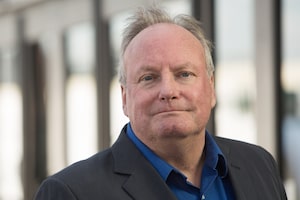
Patrick Anderson at the IWBF Men's American Cup of Wheelchair Basketball final against the U.S. team in 2017, in Cali, Colombia.AFP Contributor/Getty Images
As he nears his 42nd birthday, Patrick Anderson has drawn inspiration from Roger Federer, Tom Brady, Jaromir Jagr and other world-class athletes that have aged gracefully. He is his sport’s LeBron James but doesn’t draw comparisons to the gold-plated superstar of the Los Angeles Lakers.
Anderson is 6 foot 4 and perhaps could have earned millions in the NBA. Fate intervened when he was struck by a drunk driver as a nine-year-old and lost both legs beneath the knee. A year later he was introduced to wheelchair basketball, a sport in which he is regarded as the best player in the world and among the greatest of all time.
The Paralympics in Tokyo will be Anderson’s fifth Games since 1997, when he first joined Canada’s national team. The only one he missed was Rio de Janeiro in 2016, when he took time off to focus on his family and a music career. He and his wife, Anna Paddock, have three children and a band called The Lay Awakes. Both sing, while Anna plays the piano and he the guitar. He calls it “sappy adult contemporary music,” but it soothes his soul and achieves a long-held desire.
Officials from Team Canada tried to change his mind about competing in 2016 but could not persuade him to play.
“They asked me to think about it, but my heart was just in a different place,” Anderson says from Nagoya, Japan, where he and teammates are holed up before they travel to Tokyo. The Paralympics begin on Aug. 24 and run through Sept. 5.
At Paralympics, character outweighs characteristics
Tokyo Paralympics to be held without spectators, organizers say
Tokyo Paralympics opens repair centre for prosthetic limbs, wheelchairs in athletes’ village
Anderson led all scorers in his last Paralympics in London in 2012 when Canada won its most recent gold medal. He averaged 25 points a game then, and has averaged 21.8 points a game in 32 Paralympic contests in his career.
Canada’s men’s squad is currently ranked 18th in the world. The United States is No. 1. The Canadian women are ranked fourth behind the U.S., Spain and Australia.
“We are kind of going in blind,” Anderson says. “We haven’t played a regular game in two years and haven’t had an exhibition in a year and a half. It’s hard to know where our ceiling is.
“We are in the pack and are going to come out swinging. We have young guys that are popping and old guys that are holding on. We will have to scrap our way into contention.”
Anderson was born in Edmonton and grew up in Fergus, Ont. Like many other Canadian kids, he loved to play hockey. Then he was hit by a car and everything changed.
“The year after my accident was a year in mourning,” he says.
After his introduction to wheelchair basketball, a new possible path to the future was revealed. The first team he played for was the Twin City Spinners in Kitchener-Waterloo, Ont., under Bruce Russell.
“That planted a seed and got me kicking the tires,” Anderson says. “I was really lucky. Some people have an injury and don’t find something like that for years. It was life-changing.”
Anderson received a scholarship to play wheelchair basketball at the University of Illinois, and that led to him being recruited by professional teams in Australia and Germany. Eventually, he earned a spot on Canada’s junior national team, which he led to back-to-back world championships, and then to the senior team where he has continued to enjoy remarkable success. He won gold medals at the 2000 Paralympics in Sydney and 2004 Games in Athens, a silver in Beijing in 2008 and another gold in London.
He and his wife have lived in Brooklyn, N.Y., since 2011, where they have recorded two albums and occasionally entertain in coffee shops and theatres.
Anderson says he travelled to Japan in the spring of 2020 to make appearances for sponsors in support of the Paralympic Games.
“The talk had just started about the spectre of COVID,” he says. ”I was in a good place physically and ready to hit the road. Then the lockdown started and everything stopped.
“Initially I felt a sense of relief because it gave me more time to prepare and I didn’t have to feel like I was racing the clock. Then one by one the expectations I had that the Paralympics would be rescheduled started to fall off. There was a time in the winter where it really felt like a grind.”
His wife, a Pilates instructor, helped him stay in shape. The start of the 2020 Paralympics was moved to next week, and he began to train in New York with American wheelchair basketball team captain Steve Serio.
“I will level with you,” Anderson says. “It was a hard year on my body, and I am feeling it now. When I came back at 37, I knew 41 would feel different and at times was a real slog.”
It was then that he began to be inspired by guys such as tennis star Federer, Tampa Bay Buccaneers quarterback Brady and Jagr, who still plays in Europe at 49.
“This is a new era for the aging athlete and I thought, ‘Why not me?’ ” Anderson says. “But in the last year, I’ve had to face a biological fact. Effort is one thing, but your body being able to stay with it is another.”
If not as good as ever, he is good enough to lead Team Canada in Tokyo.
“I keep casting an eye on those other guys and day dream about putting myself in their shoes,” Anderson says. “I am tempted to envy. I wish I was one of them.”
 Marty Klinkenberg
Marty Klinkenberg